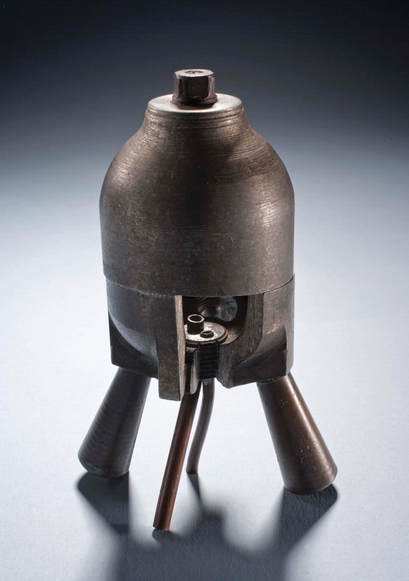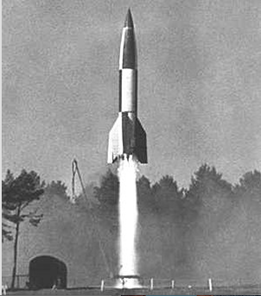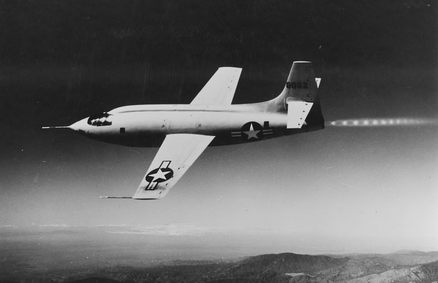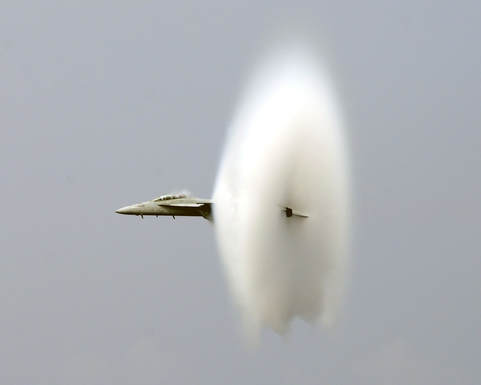 Motor of the ARS-4 Rocket
Motor of the ARS-4 Rocket
On September 9, 1934, the American Rocket Society launched a rocket designated the ARS No. 4 (or simply ARS-4) from Marine Park, Staten Island, New York. The launch of the ARS-4 is often cited as being the first instance of a rocket exceeding the speed of sound (in air), which at sea level and a temperature of 59°F is 761 mph. A closer examination of the event, however, reveals that this claim appears to be unsubstantiated. Nonetheless, the launch of the ARS-4 and the ARS itself contributed to the advancement of rocket science that was in its nascent stages at that time. In addition, the ARS-4 claim provides a good launching pad (pun intended) for a look at human-initiated supersonic travel.
The ARS was originally organized as the American Interplanetary Society on April 4, 1930 in New York City. Most of the founding members did not have a technical background. They were writers and fans of science fiction and young dreamers interested in space travel. In an effort to attract more technical people, the Society changed its name to the ARS in 1934. With a meager budget, but plenty of enthusiasm, the ARS was able to build several liquid-propellant rockets, which, at the time, were still very much a novelty. Indeed, only Dr. Robert Goddard and the German group VfR (Association for Space Travel) had previously launched liquid-propellant rockets. Altogether, the ARS attempted four rocket launches, with two of them being successful. The last of their launches was the ARS-4.
The ARS-4 had a single motor that was powered by a mixture of liquid oxygen and gasoline. The motor was mounted on top of storage tanks for the oxygen and gasoline due to the mistaken belief that this configuration would result in better flight stability. The motor had four nozzles that were directed downwardly and outwardly, away from the fuel tanks. Upon its launch, the ARS-4 had a near perfect ascent until one of the nozzles burned out at a height of several hundred feet, which caused the rocket to change direction and head downward. With the other three nozzles still firing, the ARS-4 headed toward the waters of New York Bay at an increasing velocity. Based upon calculations made from data collected from three observers at triangulation stations, and confirmed by motion picture and still photographs, the ARS-4 hit the water at a velocity of over 1,000 feet per second. This velocity converts to a speed of about 682 mph, which is impressive, but still less than the speed of sound.
The ARS was originally organized as the American Interplanetary Society on April 4, 1930 in New York City. Most of the founding members did not have a technical background. They were writers and fans of science fiction and young dreamers interested in space travel. In an effort to attract more technical people, the Society changed its name to the ARS in 1934. With a meager budget, but plenty of enthusiasm, the ARS was able to build several liquid-propellant rockets, which, at the time, were still very much a novelty. Indeed, only Dr. Robert Goddard and the German group VfR (Association for Space Travel) had previously launched liquid-propellant rockets. Altogether, the ARS attempted four rocket launches, with two of them being successful. The last of their launches was the ARS-4.
The ARS-4 had a single motor that was powered by a mixture of liquid oxygen and gasoline. The motor was mounted on top of storage tanks for the oxygen and gasoline due to the mistaken belief that this configuration would result in better flight stability. The motor had four nozzles that were directed downwardly and outwardly, away from the fuel tanks. Upon its launch, the ARS-4 had a near perfect ascent until one of the nozzles burned out at a height of several hundred feet, which caused the rocket to change direction and head downward. With the other three nozzles still firing, the ARS-4 headed toward the waters of New York Bay at an increasing velocity. Based upon calculations made from data collected from three observers at triangulation stations, and confirmed by motion picture and still photographs, the ARS-4 hit the water at a velocity of over 1,000 feet per second. This velocity converts to a speed of about 682 mph, which is impressive, but still less than the speed of sound.
 A V-2 Rocket being Launched
A V-2 Rocket being Launched
So, if the ARS-4 was not the first rocket to break the sound barrier, which rocket achieved that honor? Well, it depends on the definition of rocket. In 1933, Soviet scientists tested a ramjet engine fitted into a shell that was fired from an artillery gun. After leaving the gun barrel, the ramjet engine ignited to propel the shell to a speed of over Mach 2 (twice the speed of sound). Since the shell achieved initial flight as a result of being discharged from the gun, it is questionable whether the shell could be considered a rocket. Eliminating the Soviet ramjet shell as a candidate leaves the World War II German V2 rocket as being the first supersonic rocket. The V-2 first flew on October 3, 1942 and traveled at a maximum speed of 3,545 mph (over Mach 4). The V-2 was the world's first ballistic missile and had a range of over 200 miles.
 The Bell XS-1
The Bell XS-1
While the German V-2 was the first rocket to break the sound barrier, it was not manned. The first manned aircraft to verifiably break the sound barrier was the Bell XS-1, piloted by Chuck Yeager on October 14, 1947 over Muroc Field (later Edwards Air Force Base).The Bell XS-1 was drop launched from the bomb bay of a B-29 and reached a maximum speed of Mach 1.06.
A number of claims have been made that the Bell XS-1 was not the first airplane to exceed the speed of sound. A claim has been made that German fighter pilot Hans Guido Mutke piloting an ME-262 jet fighter broke the sound barrier while in a steep dive in 1945. Another claim has been made that German test pilot Heini Dittmar flying the ME-163 jet-powered Komet broke the sound barrier while in a steep dive in 1944. Dittmar had previously piloted the ME-163 in level flight at an officially recorded speed of 624 mph. Finally, there is a claim that American test pilot George Welch broke the sound barrier while flying a new XP-86 fighter prototype (which became the F-86 Sabre jet) less than two weeks before the record-breaking flight of the Bell XS-1. According to this claim, Welch exceeded the speed of sound while in a powered dive from 35,000 feet, resulting in several sonic booms that were heard by bystanders. Each of these claims could be true, but, nonetheless, they each remain unverified.
Now that we know that the V-2 was likely the first supersonic rocket and the Bell XS-1 was likely the first supersonic piloted airplane, we can ask the question: when was the first instance of human-initiated travel at supersonic speed? It's safe to assert that this question can never be answered. Civil War era cannons had muzzle velocities that exceeded the speed of sound. However, another human contrivance broke the sound barrier much earlier, perhaps by thousands of years. When a bullwhip is snapped, it exceeds the speed of sound and creates a crack that is a mini sonic boom. Originally, the tip of the whip (the portion that travels the fastest) was thought to create the sonic boom, but it was later proven to be caused by a loop that travels through the whip.
Since the origin of the whip is lost to the sands of time, we are already at a loss to say with any modicum of certainty when the first instance of human-initiated supersonic travel occurred. This uncertainty increases by several orders of magnitude when one considers recent findings made by Dutch and Spanish researchers studying solid-liquid impacts. These researchers found that when a solid, such as a rock, impacts a liquid, such as water, the solid makes a cavity in the liquid, which then collapses and ejects a very thin stream of air that travels at supersonic velocity. So, one of our human ancestors living hundreds of thousands, if not millions, of years ago throwing a rock into a pond or lake was likely the first instance of human-initiated supersonic travel. But this begs the question: what do we mean when we say "human"?
A number of claims have been made that the Bell XS-1 was not the first airplane to exceed the speed of sound. A claim has been made that German fighter pilot Hans Guido Mutke piloting an ME-262 jet fighter broke the sound barrier while in a steep dive in 1945. Another claim has been made that German test pilot Heini Dittmar flying the ME-163 jet-powered Komet broke the sound barrier while in a steep dive in 1944. Dittmar had previously piloted the ME-163 in level flight at an officially recorded speed of 624 mph. Finally, there is a claim that American test pilot George Welch broke the sound barrier while flying a new XP-86 fighter prototype (which became the F-86 Sabre jet) less than two weeks before the record-breaking flight of the Bell XS-1. According to this claim, Welch exceeded the speed of sound while in a powered dive from 35,000 feet, resulting in several sonic booms that were heard by bystanders. Each of these claims could be true, but, nonetheless, they each remain unverified.
Now that we know that the V-2 was likely the first supersonic rocket and the Bell XS-1 was likely the first supersonic piloted airplane, we can ask the question: when was the first instance of human-initiated travel at supersonic speed? It's safe to assert that this question can never be answered. Civil War era cannons had muzzle velocities that exceeded the speed of sound. However, another human contrivance broke the sound barrier much earlier, perhaps by thousands of years. When a bullwhip is snapped, it exceeds the speed of sound and creates a crack that is a mini sonic boom. Originally, the tip of the whip (the portion that travels the fastest) was thought to create the sonic boom, but it was later proven to be caused by a loop that travels through the whip.
Since the origin of the whip is lost to the sands of time, we are already at a loss to say with any modicum of certainty when the first instance of human-initiated supersonic travel occurred. This uncertainty increases by several orders of magnitude when one considers recent findings made by Dutch and Spanish researchers studying solid-liquid impacts. These researchers found that when a solid, such as a rock, impacts a liquid, such as water, the solid makes a cavity in the liquid, which then collapses and ejects a very thin stream of air that travels at supersonic velocity. So, one of our human ancestors living hundreds of thousands, if not millions, of years ago throwing a rock into a pond or lake was likely the first instance of human-initiated supersonic travel. But this begs the question: what do we mean when we say "human"?



